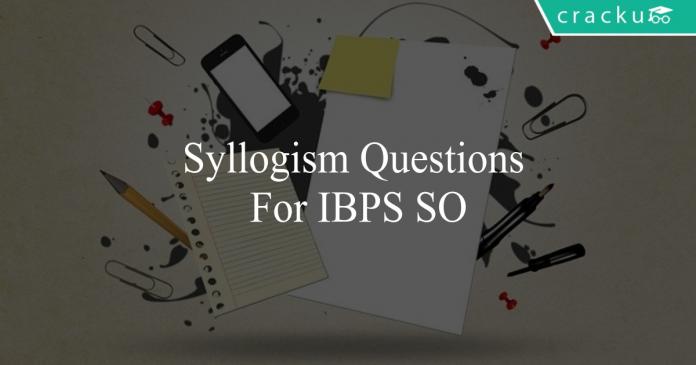Download Syllogism Questions For IBPS SO
Instructions
In the following questions two equations numbered I and II are given. You have to solve both the equations and
Give answer a: if x > y
Give answer b: if x ≥ y
Give answer c: if x < y
Give answer d: if x ≤ y
Give answer e: if x = y or the relationship cannot be established.
Question 1: I. $x^{2}-3x-88=0$
II. $y^{2}+8y-48=0$
a) if x > y
b) if x ≥ y
c) if x < y
d) if x ≤ y
e) if x = y or the relationship cannot be established.
Question 2: I. $5x^{2}+29x+20=0$
II. $25y^{2}+25y+6=0$
a) if x > y
b) if x ≥ y
c) if x < y
d) if x ≤ y
e) if x = y or the relationship cannot be established.
Question 3: I. $2x^{2}-11x+12=0$
II. $2y^{2}-19y+44=0$
a) if x > y
b) if x ≥ y
c) if x < y
d) if x ≤ y
e) if x = y or the relationship cannot be established.
Free Banking Study Material – 15000 Solved Questions
Question 4: I. $3x^{2}+10x+8=0$
II. $3y^{2}+7y+4=0$
a) if x > y
b) if x ≥ y
c) if x < y
d) if x ≤ y
e) if x = y or the relationship cannot be established.
Question 5: I. $2x^{2}+21x+10=0$
II. $3y^{2}+13y+14=0$
a) if x > y
b) if x ≥ y
c) if x < y
d) if x ≤ y
e) if x = y or the relationship cannot be established.
Instructions
In each of these questions two equations numbered I and II are given. You have to solve both the equations and –
Give answer a: if x < y
Give answer b: if x ≤ y
Give answer c: if x > y
Give answer d: if x ≥ y
Give answer e: if x = y or the relationship cannot be established.
Question 6: I. $x^{2}+13x+42=0$
II. $y^{2} +19y+90=0$
a) if x < y
b) if x ≤ y
c) if x > y
d) if x ≥ y
e) if x = y or the relationship cannot be established.
Question 7: I. $x^{2}-15x+56=0$
II. $y^{2} -23y+132=0$
a) if x < y
b) if x ≤ y
c) if x > y
d) if x ≥ y
e) if x = y or the relationship cannot be established.
Question 8: I. $x^{2}+7x+12=0$
II. $y^{2} +6y+8=0$
a) if x < y
b) if x ≤ y
c) if x > y
d) if x ≥ y
e) if x = y or the relationship cannot be established.
Question 9: I. $x^{2}-22x+120=0$
II. $y^{2} -26y+168=0$
a) if x < y
b) if x ≤ y
c) if x > y
d) if x ≥ y
e) if x = y or the relationship cannot be established.
Question 10: I.$x^{2}+12x+32=0$
II. $y^{2} +17y+72=0$
a) if x < y
b) if x ≤ y
c) if x > y
d) if x ≥ y
e) if x = y or the relationship cannot be established.
Instructions
In each of the following questions, two equations I and II have been given.
Solve these questions and answer
(1)if x < y
(2) if x ≤ y
(3) if x = y or the relation cannot be established
(4) if ≥ y
(5) if x > y
Question 11: I. $30 x^{2} + 11x + 1 = 0$
II. $42 y^{2} + 13y + 1 = 0$
a) if x < y
b) if x ≤ y
c) if x = y or the relation cannot be established
d) if ≥ y
e) if x > y
Question 12: I. $x^{2}- x – \sqrt{2}x + \sqrt{2}=0$
II.$y^{2}-3y+2=0$
a) if x < y
b) if x ≤ y
c) if x = y or the relation cannot be established
d) if ≥ y
e) if x > y
200+ Banking Previous Papers (Download PDF)
Question 13: I.$x^{2}-2x-\sqrt{5}x+2\sqrt{5}=0$
II.$y^{2}-\sqrt{3}y-\sqrt{2}y+\sqrt{6}=0$
a) if x < y
b) if x ≤ y
c) if x = y or the relation cannot be established
d) if ≥ y
e) if x > y
Question 14: I.$ x^{2}+12x+36=0$
II.$y^{2}=16$
a) if x < y
b) if x ≤ y
c) if x = y or the relation cannot be established
d) if ≥ y
e) if x > y
Question 15: I.$9x^{2}+3x-2=0$
II.$8y^{2}+6y+1=0$
a) if x < y
b) if x ≤ y
c) if x = y or the relation cannot be established
d) if ≥ y
e) if x > y
Free Banking Study Material (15000 Solved Questions)
Answers & Solutions:
1) Answer (E)
I.$x^{2} – 3x – 88 = 0$
=> $x^2 + 8x – 11x – 88 = 0$
=> $x (x + 8) – 11 (x + 8) = 0$
=> $(x + 8) (x – 11) = 0$
=> $x = -8 , 11$
II.$y^{2} + 8y – 48 = 0$
=> $y^2 + 12y – 4y – 48 = 0$
=> $y (y + 12) – 4 (y + 12) = 0$
=> $(y + 12) (y – 4) = 0$
=> $y = -12 , 4$
$\therefore$ No relation can be established.
2) Answer (C)
I.$5x^{2} + 29x + 20 = 0$
=> $5x^2 + 25x + 4x + 20 = 0$
=> $5x (x + 5) + 4 (x + 5) = 0$
=> $(x + 5) (5x + 4) = 0$
=> $x = -5 , \frac{-4}{5}$
II.$25y^{2} + 25y + 6 = 0$
=> $25y^2 + 10y + 15y + 6 = 0$
=> $5y (5y + 2) + 3 (5y + 2) = 0$
=> $(5y + 3) (5y + 2) = 0$
=> $y = \frac{-3}{5} , \frac{-2}{5}$
Therefore $x < y$
3) Answer (D)
I.$2x^{2} – 11x + 12 = 0$
=> $2x^2 – 8x – 3x + 12 = 0$
=> $2x (x – 4) – 3 (x – 4) = 0$
=> $(x – 4) (2x – 3) = 0$
=> $x = 4 , \frac{3}{2}$
II.$2y^{2} – 19y + 44 = 0$
=> $2y^2 – 8y – 11y + 44 = 0$
=> $2y (y – 4) – 11 (y – 4) = 0$
=> $(y – 4) (2y – 11) = 0$
=> $y = 4 , \frac{11}{2}$
$\therefore x \leq y$
4) Answer (D)
I.$3x^{2} + 10x + 8 = 0$
=> $3x^2 + 6x + 4x + 8 = 0$
=> $3x (x + 2) + 4 (x + 2) = 0$
=> $(x + 2) (3x + 4) = 0$
=> $x = -2 , \frac{-4}{3}$
II.$3y^{2} + 7y + 4 = 0$
=> $3y^2 + 3y + 4y + 4 = 0$
=> $3y (y + 1) + 4 (y + 1) = 0$
=> $(y + 1) (3y + 4) = 0$
=> $y = -1 , \frac{-4}{3}$
$\therefore x \leq y$
5) Answer (E)
I.$2x^{2} + 21x + 10 = 0$
=> $2x^2 + x + 20x + 10 = 0$
=> $x (2x + 1) + 10 (2x + 1) = 0$
=> $(x + 10) (2x + 1) = 0$
=> $x = -10 , \frac{-1}{2}$
II.$3y^{2} + 13y + 14 = 0$
=> $3y^2 + 6y + 7y + 14 = 0$
=> $3y (y + 2) + 7 (y + 2) = 0$
=> $(y + 2) (3y + 7) = 0$
=> $y = -2 , \frac{-7}{3}$
$\therefore$ No relation can be established.
6) Answer (C)
I.$x^{2} + 13x + 42 = 0$
=> $x^2 + 7x + 6x + 42 = 0$
=> $x (x + 7) + 6 (x + 7) = 0$
=> $(x + 7) (x + 6) = 0$
=> $x = -7 , -6$
II.$y^{2} + 19y + 90 = 0$
=> $y^2 + 9y + 10y + 90 = 0$
=> $y (y + 9) + 10 (y + 9) = 0$
=> $(y + 9) (y + 10) = 0$
=> $y = -9 , -10$
$\therefore x > y$
7) Answer (A)
I.$x^{2} – 15x + 56 = 0$
=> $x^2 – 8x – 7x + 56 = 0$
=> $x (x – 8) – 7 (x – 8) = 0$
=> $(x – 8) (x – 7) = 0$
=> $x = 8 , 7$
II.$y^{2} – 23y + 132 = 0$
=> $y^2 – 11y – 12y + 132 = 0$
=> $y (y – 11) – 12 (y – 11) = 0$
=> $(y – 11) (y – 12) = 0$
=> $y = 11 , 12$
$\therefore x < y$
8) Answer (E)
I.$x^{2} + 7x + 12 = 0$
=> $x^2 + 3x + 4x + 12 = 0$
=> $x (x + 3) + 4 (x + 3) = 0$
=> $(x + 3) (x + 4) = 0$
=> $x = -3 , -4$
II.$y^{2} + 6y + 8 = 0$
=> $y^2 + 4y + 2y + 8 = 0$
=> $y (y + 4) + 2 (y + 4) = 0$
=> $(y + 4) (y + 2) = 0$
=> $y = -4 , -2$
Because $-2 > -4$ and $-3 > -4$
Therefore, no relation can be established.
9) Answer (B)
I.$x^{2} – 22x + 120 = 0$
=> $x^2 – 10x – 12x + 120 = 0$
=> $x (x – 10) – 12 (x – 10) = 0$
=> $(x – 10) (x – 12) = 0$
=> $x = 10 , 12$
II.$y^{2} – 26y + 168 = 0$
=> $y^2 – 12y – 14y + 168 = 0$
=> $y (y – 12) – 14 (y – 12) = 0$
=> $(y – 12) (y – 14) = 0$
=> $y = 12 , 14$
$\therefore x \leq y$
10) Answer (D)
I.$x^{2} + 12x + 32 = 0$
=> $x^2 + 8x + 4x + 32 = 0$
=> $x (x + 8) + 4 (x + 8) = 0$
=> $(x + 8) (x + 4) = 0$
=> $x = -8 , -4$
II.$y^{2} + 17y + 72 = 0$
=> $y^2 + 9y + 8y + 72 = 0$
=> $y (y + 9) + 8 (y + 9) = 0$
=> $(y + 9) (y + 8) = 0$
=> $y = -9 , -8$
$\therefore x \geq y$
11) Answer (B)
Statement I : $30 x^{2} + 11x + 1 = 0$
=> $30x^2 + 6x + 5x + 1 = 0$
=> $6x (5x + 1) + 1 (5x + 1) = 0$
=> $(6x + 1) (5x + 1) = 0$
=> $x = \frac{-1}{6} , \frac{-1}{5}$
Statement II : $42 y^{2} + 13y + 1 = 0$
=> $42y^2 + 7y + 6y + 1 = 0$
=> $7y (6y + 1) + 1 (6y + 1) = 0$
=> $(7y + 1) (6y + 1) = 0$
=> $y = \frac{-1}{7} , \frac{-1}{6}$
$\therefore$ $x \leq y$
12) Answer (C)
I. $x^{2}- x – \sqrt{2}x + \sqrt{2}=0$
=> $x (x – 1) – \sqrt{2} (x – 1) = 0$
=> $(x – \sqrt{2}) (x – 1) = 0$
=> $x = \sqrt{2} , 1$
II. $y^{2}-3y+2=0$
=> $y^2 – 2y – y + 2 = 0$
=> $y (y – 2) – 1 (y – 2) = 0$
=> $(y – 2) (y – 1) = 0$
=> $y = 1 , 2$
$\therefore$ No relation established.
13) Answer (E)
Statement I : $x^{2}-2x-\sqrt{5}x+2\sqrt{5}=0$
=> $x (x – 2) – \sqrt{5} (x – 2) = 0$
=> $(x – \sqrt{5}) (x – 2) = 0$
=> $x = \sqrt{5} , 2$
Statement II : $y^{2}-\sqrt{3}y-\sqrt{2}y+\sqrt{6}=0$
=> $y (y – \sqrt{3}) – \sqrt{2} (y – \sqrt{3}) = 0$
=> $(y – \sqrt{2}) (y – \sqrt{3}) = 0$
=> $y = \sqrt{2} , \sqrt{3}$
$\therefore$ $x > y$
14) Answer (A)
Statement 1 : $x^2 + 12x + 36 = 0$
=> $x^2 + 2.x.6 + 6^2 = 0$
=> $(x + 6)^2 = 0$
=> $x = -6$
Statement II : $y^2 = 16$
=> $(y)^2 = (\pm 4)^2$
=> $y = \pm 4$
$\therefore$ $x < y$
15) Answer (C)
Statement I : $9x^{2}+3x-2=0$
=> $9x^2 + 6x – 3x – 2 = 0$
=> $3x (3x + 2) – 1 (3x + 2) = 0$
=> $(3x – 1) (3x + 2) = 0$
=> $x = \frac{1}{3} , \frac{-2}{3}$
Statement II : $8y^{2}+6y+1=0$
=> $8y^2 + 4y + 2y + 1 = 0$
=> $4y (2y + 1) + 1 (2y + 1) = 0$
=> $(4y + 1) (2y + 1) = 0$
=> $y = \frac{-1}{4} , \frac{-1}{2}$
$\therefore$ No relation can be established.





![Important Festivals of India | State-wise | Download [PDF] Important Festivals in India](https://cracku.in/blog/wp-content/uploads/2021/03/Important-Festivals-in-India-1-218x150.png)